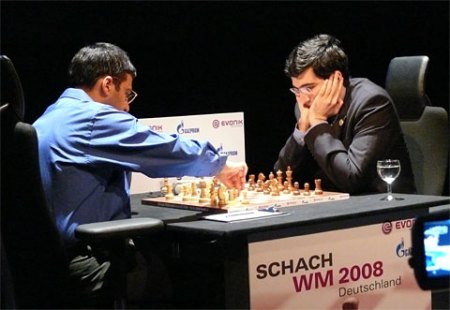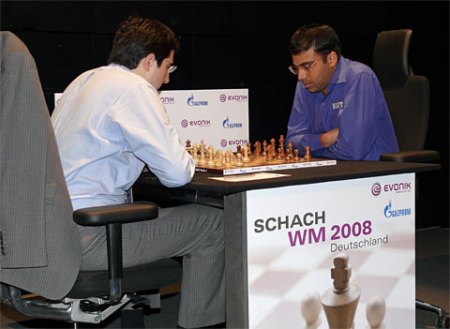The second game from the 2008 World Chess Championship ended in a draw. In an attempt to show off some of his preparation for playing white against the Slav(1.d4 d5 2.c4 c6), Anand decided to use 1.d4 instead of his favorite 1.e4. Kramnik avoided the technical Slav lines in game 1 and chose to use the Nimzo-Indian Defence(1.d4 Nf6 2.c4 e6 3.Nc3 Bb4) in game 2. Perhaps Kramnik is concerned about Anand’s knowledge in the Slav. This game becomes very complicated very quickly after Anand plays the surprising 4.f3 which is a favorite of Russian grandmaster Yuri Yakovich. Below is my analysis on the game:
4. f3 Anand is clearly playing for a win when he chooses this more complicated move. e4 tends to be a ver important square in such positions and the pawn on f3 exerts its influence there.
4…c5 Kramnik chooses a safer move than 4…c5.
5. a3 Welcome to the Saemisch Variation. This variation is highly theoretical and generally continues the way our current game does.
8…f5 Kramnik chooses not to play the popular 8…Qa5.
9…Nd7 Kramnik avoids the more common 9…0-0 10.e4 or 9…f4 10.e4 fxe3 11.Bd3. In placing the knight on d7 he prepares to move it to c5.
12. c6 Anand gets rid of a dead pawn by weakening his opponent’s pawn structure first.
14… Ba6 Kramnik wants to trade bishops so Anand no longer has the bishop pair.
15. c4 Anand could have played 15.Bxa6 Qxa6 and then 16.c4 0-0 17.0-0
Anand could have also tried the exciting 15.Ng5 Bxf1 16.Rxf1 Nc5 17.Rf3.
16…Ng4 I really like this aggressive move. Kramnik proves to his critics that he does not always choose the most “boring” approach.
17…Qe3+ Kramnik also could have played 17…Qb6 18.h3 Ne3 19.Qd2 Bxc4 20.Bxc4 Nxc4 21.Qg5 Qe3 22.Qxe3 Nxe3 and black has good compensation.
21…Ndf6 Another aggressive move by Kramnik. Now his rook on d8 is much better but at the price of one pawn. 21…h5 is the solid choice Kramnik could have chosen.
27…e5 Kramnik is rolling now. Kramnik’s pawn sacrifice allowed him to get his pieces to much better squares than Anand finds his pieces in.
30. Rc3 I like Anand’s position after 30.Bxd3 Rxd3 31.Kg4 Rd4 32.Kf5 Rh5 33.Kg6
31. Bc2 Anand misses 31.Rf2 Rh6 32.h4 Ne6 which seems better.
32…Rd4 The two champions agreed to a draw. Its a shame as their seemed to be a lot of chess left in this position. Keep in mind that Anand was in time trouble. Play
could have continued:
33. c5 Nf4 34. Re3 Bc4 35. Rb2 Rh6 36. Kh2 Rg6 37. g3 Nd3 38. Bxd3 Rxd3 39.
Rxd3 Bxd3
[Event “Anand-Kramnik World Championship Match”]
[Site “0:08:00-0:13:00”]
[Date “2008.10.15”]
[EventDate “2008.10.14”]
[Round “2”]
[Result “1/2-1/2”]
[White “Anand”]
[Black “Kramnik”]
[ECO “E25”]
[WhiteElo “?”]
[BlackElo “?”]
[PlyCount “64”]
1. d4 Nf6 2. c4 e6 3. Nc3 Bb4 4. f3 d5 5. a3 Bxc3+ 6. bxc3 c5 7. cxd5 Nxd5 8.
dxc5 f5 9. Qc2 Nd7 10. e4 fxe4 11. fxe4 N5f6 12. c6 bxc6 13. Nf3 Qa5 14. Bd2
Ba6 15. c4 Qc5 16. Bd3 Ng4 17. Bb4 Qe3+ 18. Qe2 O-O-O 19. Qxe3 Nxe3 20. Kf2
Ng4+ 21. Kg3 Ndf6 22. Bb1 h5 23. h3 h4+ 24. Nxh4 Ne5 25. Nf3 Nh5+ 26. Kf2 Nxf3
27. Kxf3 e5 28. Rc1 Nf4 29. Ra2 Nd3 30. Rc3 Nf4 31. Bc2 Ne6 32. Kg3 Rd4 1/2-1/2


